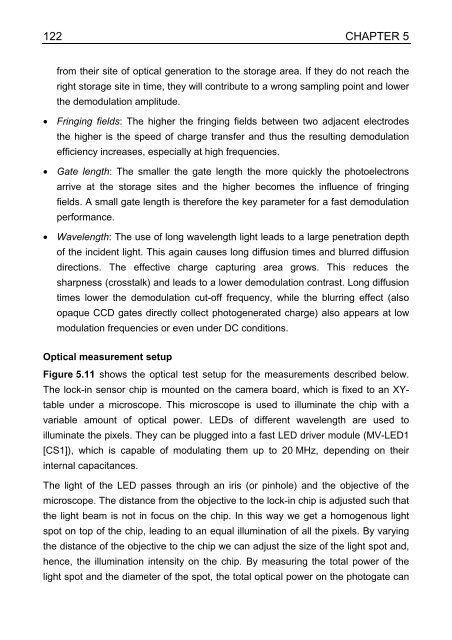3D Time-of-flight distance measurement with custom - Universität ...
3D Time-of-flight distance measurement with custom - Universität ...
3D Time-of-flight distance measurement with custom - Universität ...
You also want an ePaper? Increase the reach of your titles
YUMPU automatically turns print PDFs into web optimized ePapers that Google loves.
122 CHAPTER 5<br />
from their site <strong>of</strong> optical generation to the storage area. If they do not reach the<br />
right storage site in time, they will contribute to a wrong sampling point and lower<br />
the demodulation amplitude.<br />
• Fringing fields: The higher the fringing fields between two adjacent electrodes<br />
the higher is the speed <strong>of</strong> charge transfer and thus the resulting demodulation<br />
efficiency increases, especially at high frequencies.<br />
• Gate length: The smaller the gate length the more quickly the photoelectrons<br />
arrive at the storage sites and the higher becomes the influence <strong>of</strong> fringing<br />
fields. A small gate length is therefore the key parameter for a fast demodulation<br />
performance.<br />
• Wavelength: The use <strong>of</strong> long wavelength light leads to a large penetration depth<br />
<strong>of</strong> the incident light. This again causes long diffusion times and blurred diffusion<br />
directions. The effective charge capturing area grows. This reduces the<br />
sharpness (crosstalk) and leads to a lower demodulation contrast. Long diffusion<br />
times lower the demodulation cut-<strong>of</strong>f frequency, while the blurring effect (also<br />
opaque CCD gates directly collect photogenerated charge) also appears at low<br />
modulation frequencies or even under DC conditions.<br />
Optical <strong>measurement</strong> setup<br />
Figure 5.11 shows the optical test setup for the <strong>measurement</strong>s described below.<br />
The lock-in sensor chip is mounted on the camera board, which is fixed to an XYtable<br />
under a microscope. This microscope is used to illuminate the chip <strong>with</strong> a<br />
variable amount <strong>of</strong> optical power. LEDs <strong>of</strong> different wavelength are used to<br />
illuminate the pixels. They can be plugged into a fast LED driver module (MV-LED1<br />
[CS1]), which is capable <strong>of</strong> modulating them up to 20 MHz, depending on their<br />
internal capacitances.<br />
The light <strong>of</strong> the LED passes through an iris (or pinhole) and the objective <strong>of</strong> the<br />
microscope. The <strong>distance</strong> from the objective to the lock-in chip is adjusted such that<br />
the light beam is not in focus on the chip. In this way we get a homogenous light<br />
spot on top <strong>of</strong> the chip, leading to an equal illumination <strong>of</strong> all the pixels. By varying<br />
the <strong>distance</strong> <strong>of</strong> the objective to the chip we can adjust the size <strong>of</strong> the light spot and,<br />
hence, the illumination intensity on the chip. By measuring the total power <strong>of</strong> the<br />
light spot and the diameter <strong>of</strong> the spot, the total optical power on the photogate can

















